Critical Appraisal of a Study on Drug Use at Music Festivals
VerifiedAdded on 2022/10/31
|7
|1785
|398
Report
AI Summary
This assignment critically appraises a cross-sectional study by Day et al. (2018) investigating illicit drug use among music festival attendees. The appraisal examines the study's authorship, research question, design, methods, results, and limitations. The study, conducted at an Australian music festival, surveyed attendees about their drug use, attitudes toward drug checking, and practices regarding drug content and purity. The report highlights the study's strengths, such as its use of a self-constructed survey and anonymous data collection, while acknowledging limitations like the skewed gender ratio of participants. The assignment also correlates the study's findings with a case study of Emily, a young woman attending a music festival, and discusses the implications of the research for clinical settings, particularly concerning drug checking as a harm reduction strategy. The conclusion emphasizes the importance of understanding and addressing illicit drug use among young populations, reinforcing the positive impact of drug checking techniques.
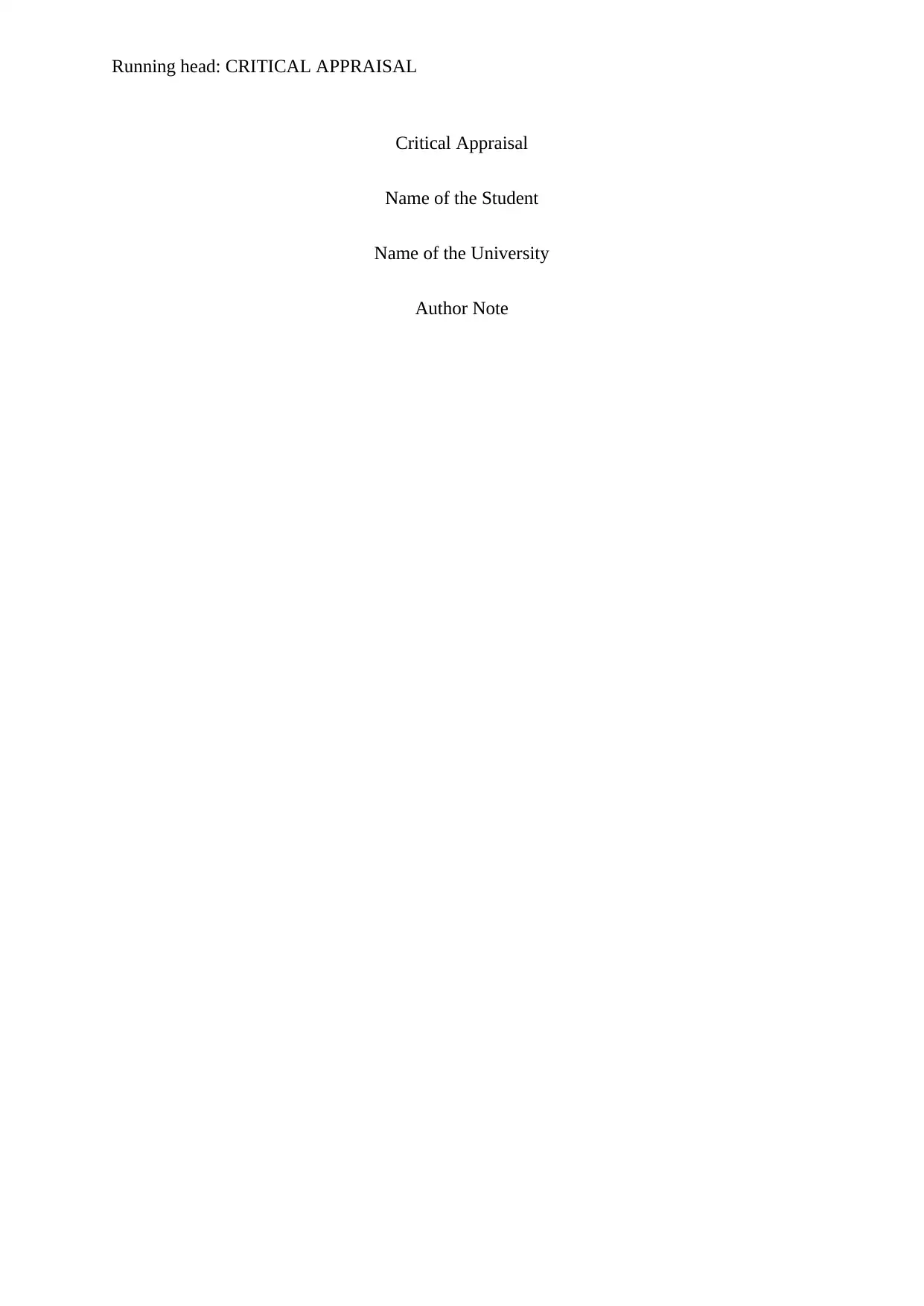
Running head: CRITICAL APPRAISAL
Critical Appraisal
Name of the Student
Name of the University
Author Note
Critical Appraisal
Name of the Student
Name of the University
Author Note
Paraphrase This Document
Need a fresh take? Get an instant paraphrase of this document with our AI Paraphraser
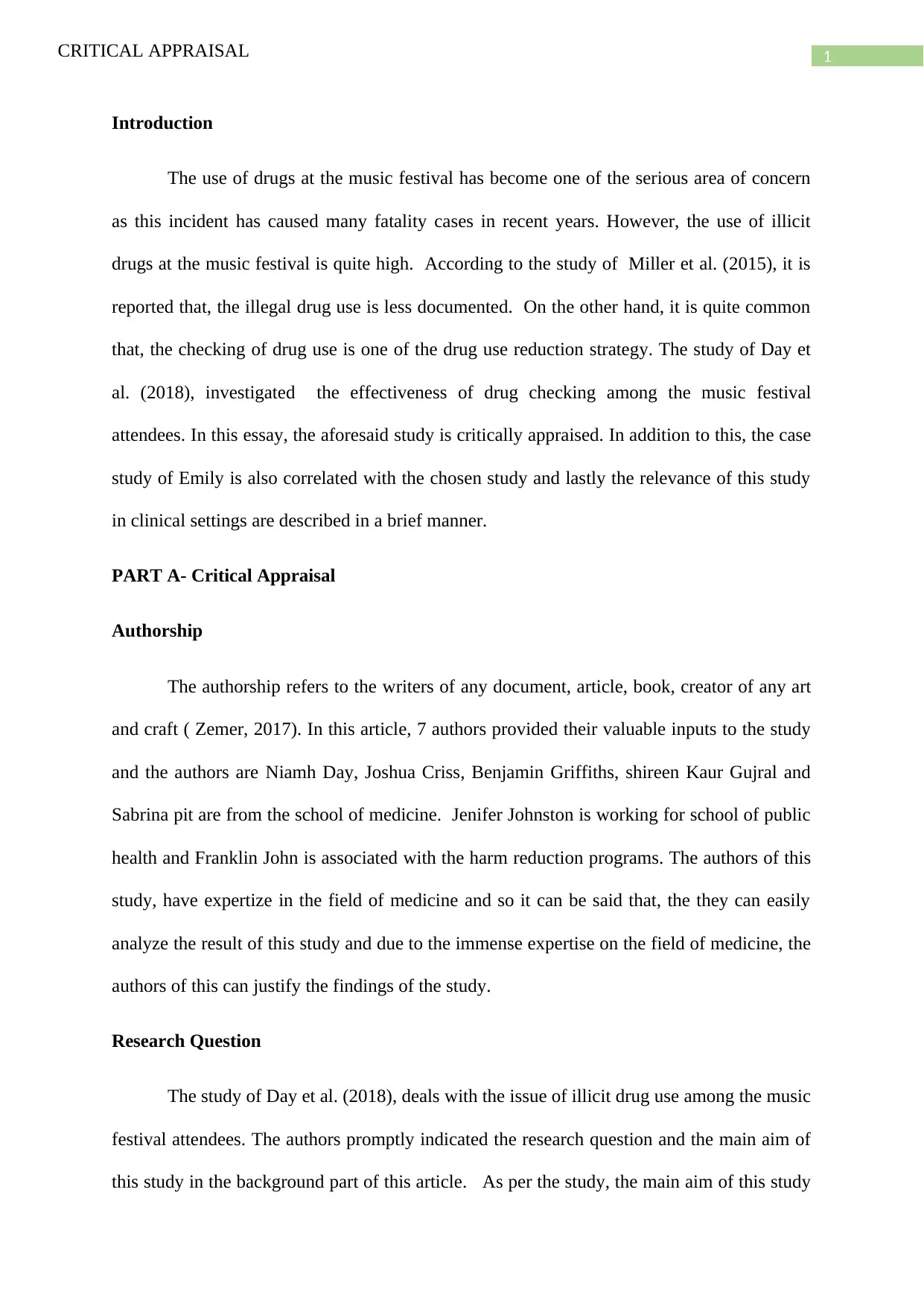
1CRITICAL APPRAISAL
Introduction
The use of drugs at the music festival has become one of the serious area of concern
as this incident has caused many fatality cases in recent years. However, the use of illicit
drugs at the music festival is quite high. According to the study of Miller et al. (2015), it is
reported that, the illegal drug use is less documented. On the other hand, it is quite common
that, the checking of drug use is one of the drug use reduction strategy. The study of Day et
al. (2018), investigated the effectiveness of drug checking among the music festival
attendees. In this essay, the aforesaid study is critically appraised. In addition to this, the case
study of Emily is also correlated with the chosen study and lastly the relevance of this study
in clinical settings are described in a brief manner.
PART A- Critical Appraisal
Authorship
The authorship refers to the writers of any document, article, book, creator of any art
and craft ( Zemer, 2017). In this article, 7 authors provided their valuable inputs to the study
and the authors are Niamh Day, Joshua Criss, Benjamin Griffiths, shireen Kaur Gujral and
Sabrina pit are from the school of medicine. Jenifer Johnston is working for school of public
health and Franklin John is associated with the harm reduction programs. The authors of this
study, have expertize in the field of medicine and so it can be said that, the they can easily
analyze the result of this study and due to the immense expertise on the field of medicine, the
authors of this can justify the findings of the study.
Research Question
The study of Day et al. (2018), deals with the issue of illicit drug use among the music
festival attendees. The authors promptly indicated the research question and the main aim of
this study in the background part of this article. As per the study, the main aim of this study
Introduction
The use of drugs at the music festival has become one of the serious area of concern
as this incident has caused many fatality cases in recent years. However, the use of illicit
drugs at the music festival is quite high. According to the study of Miller et al. (2015), it is
reported that, the illegal drug use is less documented. On the other hand, it is quite common
that, the checking of drug use is one of the drug use reduction strategy. The study of Day et
al. (2018), investigated the effectiveness of drug checking among the music festival
attendees. In this essay, the aforesaid study is critically appraised. In addition to this, the case
study of Emily is also correlated with the chosen study and lastly the relevance of this study
in clinical settings are described in a brief manner.
PART A- Critical Appraisal
Authorship
The authorship refers to the writers of any document, article, book, creator of any art
and craft ( Zemer, 2017). In this article, 7 authors provided their valuable inputs to the study
and the authors are Niamh Day, Joshua Criss, Benjamin Griffiths, shireen Kaur Gujral and
Sabrina pit are from the school of medicine. Jenifer Johnston is working for school of public
health and Franklin John is associated with the harm reduction programs. The authors of this
study, have expertize in the field of medicine and so it can be said that, the they can easily
analyze the result of this study and due to the immense expertise on the field of medicine, the
authors of this can justify the findings of the study.
Research Question
The study of Day et al. (2018), deals with the issue of illicit drug use among the music
festival attendees. The authors promptly indicated the research question and the main aim of
this study in the background part of this article. As per the study, the main aim of this study
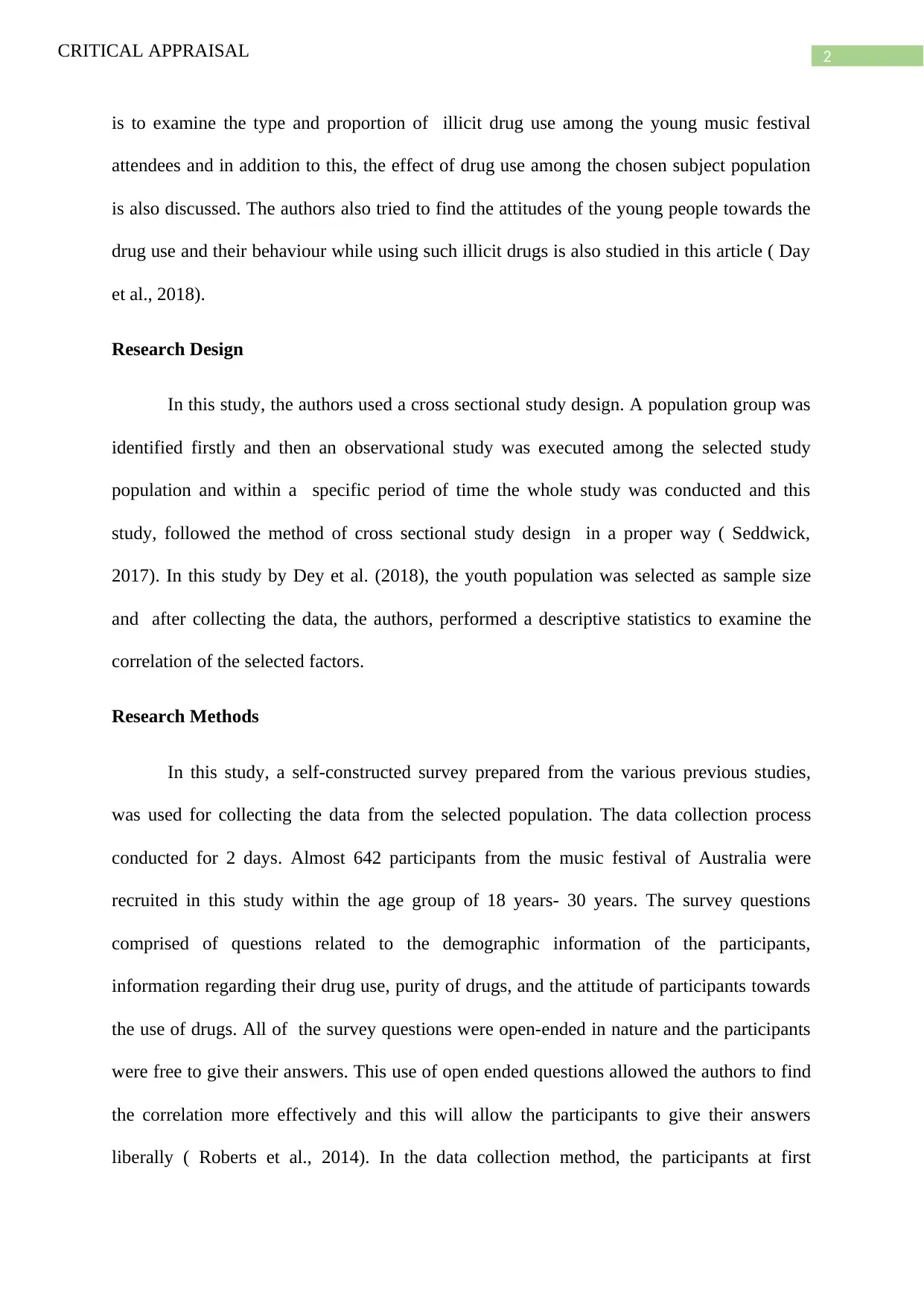
2CRITICAL APPRAISAL
is to examine the type and proportion of illicit drug use among the young music festival
attendees and in addition to this, the effect of drug use among the chosen subject population
is also discussed. The authors also tried to find the attitudes of the young people towards the
drug use and their behaviour while using such illicit drugs is also studied in this article ( Day
et al., 2018).
Research Design
In this study, the authors used a cross sectional study design. A population group was
identified firstly and then an observational study was executed among the selected study
population and within a specific period of time the whole study was conducted and this
study, followed the method of cross sectional study design in a proper way ( Seddwick,
2017). In this study by Dey et al. (2018), the youth population was selected as sample size
and after collecting the data, the authors, performed a descriptive statistics to examine the
correlation of the selected factors.
Research Methods
In this study, a self-constructed survey prepared from the various previous studies,
was used for collecting the data from the selected population. The data collection process
conducted for 2 days. Almost 642 participants from the music festival of Australia were
recruited in this study within the age group of 18 years- 30 years. The survey questions
comprised of questions related to the demographic information of the participants,
information regarding their drug use, purity of drugs, and the attitude of participants towards
the use of drugs. All of the survey questions were open-ended in nature and the participants
were free to give their answers. This use of open ended questions allowed the authors to find
the correlation more effectively and this will allow the participants to give their answers
liberally ( Roberts et al., 2014). In the data collection method, the participants at first
is to examine the type and proportion of illicit drug use among the young music festival
attendees and in addition to this, the effect of drug use among the chosen subject population
is also discussed. The authors also tried to find the attitudes of the young people towards the
drug use and their behaviour while using such illicit drugs is also studied in this article ( Day
et al., 2018).
Research Design
In this study, the authors used a cross sectional study design. A population group was
identified firstly and then an observational study was executed among the selected study
population and within a specific period of time the whole study was conducted and this
study, followed the method of cross sectional study design in a proper way ( Seddwick,
2017). In this study by Dey et al. (2018), the youth population was selected as sample size
and after collecting the data, the authors, performed a descriptive statistics to examine the
correlation of the selected factors.
Research Methods
In this study, a self-constructed survey prepared from the various previous studies,
was used for collecting the data from the selected population. The data collection process
conducted for 2 days. Almost 642 participants from the music festival of Australia were
recruited in this study within the age group of 18 years- 30 years. The survey questions
comprised of questions related to the demographic information of the participants,
information regarding their drug use, purity of drugs, and the attitude of participants towards
the use of drugs. All of the survey questions were open-ended in nature and the participants
were free to give their answers. This use of open ended questions allowed the authors to find
the correlation more effectively and this will allow the participants to give their answers
liberally ( Roberts et al., 2014). In the data collection method, the participants at first
⊘ This is a preview!⊘
Do you want full access?
Subscribe today to unlock all pages.

Trusted by 1+ million students worldwide

3CRITICAL APPRAISAL
completed a paper based survey. All the participants of this study were grouped in an age
related manner and as a result, the authors easily compared the study result in terms of
different age group. In addition to this, the authors allowed the respondents to keep their
identity anonymous while conducting the paper based survey and this might encourage the
participants to freely answer the questions of the survey ( Jhonston, 2017). In this study,
SPSS (Version 22 ) was used to analyse the collected data.
Result and Limitations
The study result showed that, two-third of the population attended the music festival
occurred in Melbourne and they were in the age group of 18-30 years. Among them, half of
the participants, used illicit drugs at least once in their life. From the study result, it was
observed that, the users of the drugs, mostly used two types of illicit drugs and the mostly
used drugs by the young music festival attendees were ecstasy and cannabis (Day et al.,
2018). In addition to this, it was observed that, this checking method was very useful to make
people understand about the harmful effect of those drugs among the users and this method
also helped the users to avoid such things in future (Soukup-Baljak et al., 2015). However,
like every study, this article also had a few limitations. Firstly, the subject population was
dominant by the number of female participants and this can be one of the limitations as it is
quite evident that female used less amount of drugs. The second limitation of this study is
that, the study is based on the life time drug use of the participants ((Day et al., 2018).
PART B – Application of evidence to practice
The case study of Emily showed that, the Emily is going to attend a music festival in
Melbourne and her mother is worried about drug testing in the music festivals as she thinks
that this process will encourage the people to use illicit drugs. However, this conception is
completely wrong and this process will help Emily to avoid drug use in music festivals.
completed a paper based survey. All the participants of this study were grouped in an age
related manner and as a result, the authors easily compared the study result in terms of
different age group. In addition to this, the authors allowed the respondents to keep their
identity anonymous while conducting the paper based survey and this might encourage the
participants to freely answer the questions of the survey ( Jhonston, 2017). In this study,
SPSS (Version 22 ) was used to analyse the collected data.
Result and Limitations
The study result showed that, two-third of the population attended the music festival
occurred in Melbourne and they were in the age group of 18-30 years. Among them, half of
the participants, used illicit drugs at least once in their life. From the study result, it was
observed that, the users of the drugs, mostly used two types of illicit drugs and the mostly
used drugs by the young music festival attendees were ecstasy and cannabis (Day et al.,
2018). In addition to this, it was observed that, this checking method was very useful to make
people understand about the harmful effect of those drugs among the users and this method
also helped the users to avoid such things in future (Soukup-Baljak et al., 2015). However,
like every study, this article also had a few limitations. Firstly, the subject population was
dominant by the number of female participants and this can be one of the limitations as it is
quite evident that female used less amount of drugs. The second limitation of this study is
that, the study is based on the life time drug use of the participants ((Day et al., 2018).
PART B – Application of evidence to practice
The case study of Emily showed that, the Emily is going to attend a music festival in
Melbourne and her mother is worried about drug testing in the music festivals as she thinks
that this process will encourage the people to use illicit drugs. However, this conception is
completely wrong and this process will help Emily to avoid drug use in music festivals.
Paraphrase This Document
Need a fresh take? Get an instant paraphrase of this document with our AI Paraphraser
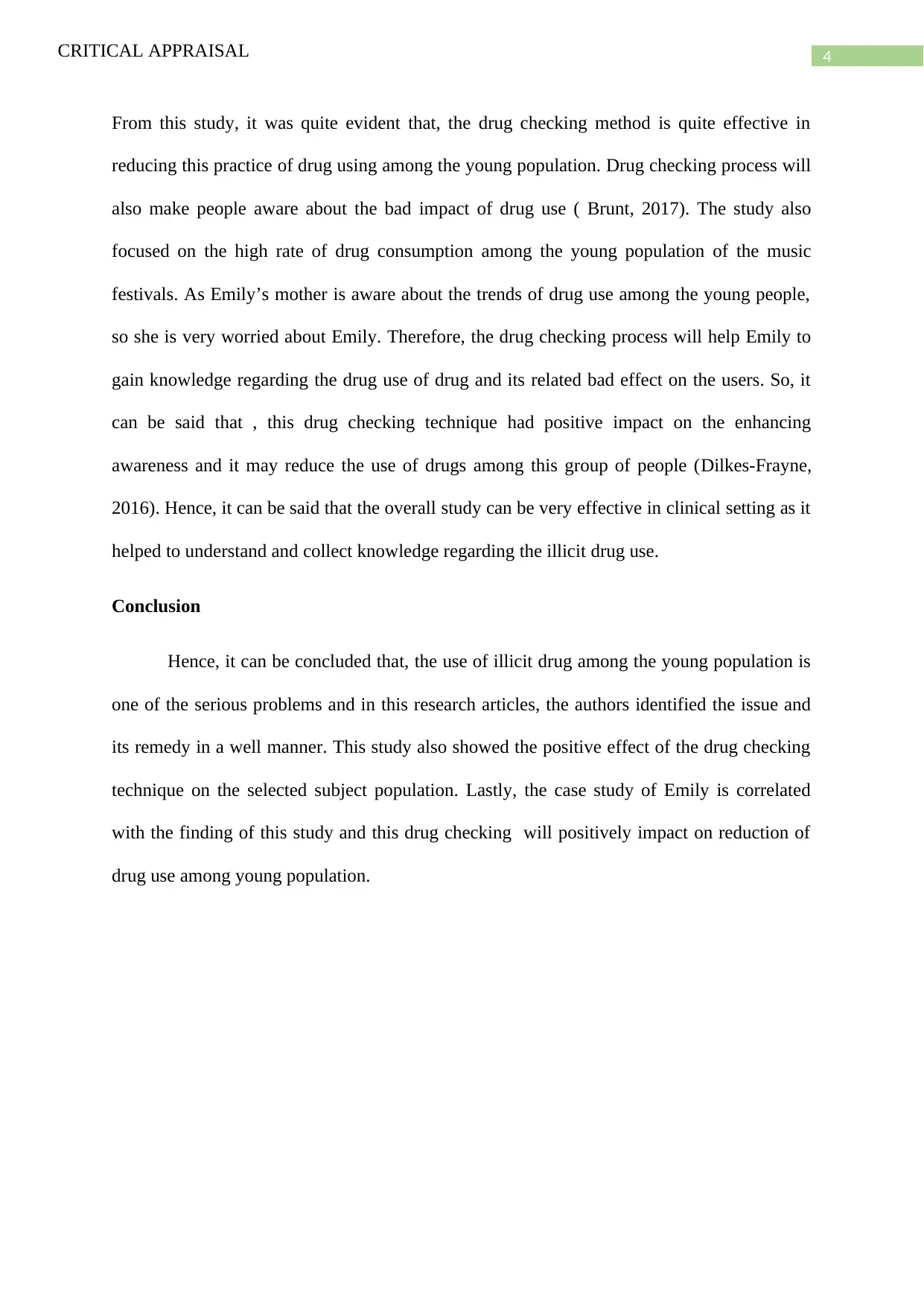
4CRITICAL APPRAISAL
From this study, it was quite evident that, the drug checking method is quite effective in
reducing this practice of drug using among the young population. Drug checking process will
also make people aware about the bad impact of drug use ( Brunt, 2017). The study also
focused on the high rate of drug consumption among the young population of the music
festivals. As Emily’s mother is aware about the trends of drug use among the young people,
so she is very worried about Emily. Therefore, the drug checking process will help Emily to
gain knowledge regarding the drug use of drug and its related bad effect on the users. So, it
can be said that , this drug checking technique had positive impact on the enhancing
awareness and it may reduce the use of drugs among this group of people (Dilkes-Frayne,
2016). Hence, it can be said that the overall study can be very effective in clinical setting as it
helped to understand and collect knowledge regarding the illicit drug use.
Conclusion
Hence, it can be concluded that, the use of illicit drug among the young population is
one of the serious problems and in this research articles, the authors identified the issue and
its remedy in a well manner. This study also showed the positive effect of the drug checking
technique on the selected subject population. Lastly, the case study of Emily is correlated
with the finding of this study and this drug checking will positively impact on reduction of
drug use among young population.
From this study, it was quite evident that, the drug checking method is quite effective in
reducing this practice of drug using among the young population. Drug checking process will
also make people aware about the bad impact of drug use ( Brunt, 2017). The study also
focused on the high rate of drug consumption among the young population of the music
festivals. As Emily’s mother is aware about the trends of drug use among the young people,
so she is very worried about Emily. Therefore, the drug checking process will help Emily to
gain knowledge regarding the drug use of drug and its related bad effect on the users. So, it
can be said that , this drug checking technique had positive impact on the enhancing
awareness and it may reduce the use of drugs among this group of people (Dilkes-Frayne,
2016). Hence, it can be said that the overall study can be very effective in clinical setting as it
helped to understand and collect knowledge regarding the illicit drug use.
Conclusion
Hence, it can be concluded that, the use of illicit drug among the young population is
one of the serious problems and in this research articles, the authors identified the issue and
its remedy in a well manner. This study also showed the positive effect of the drug checking
technique on the selected subject population. Lastly, the case study of Emily is correlated
with the finding of this study and this drug checking will positively impact on reduction of
drug use among young population.
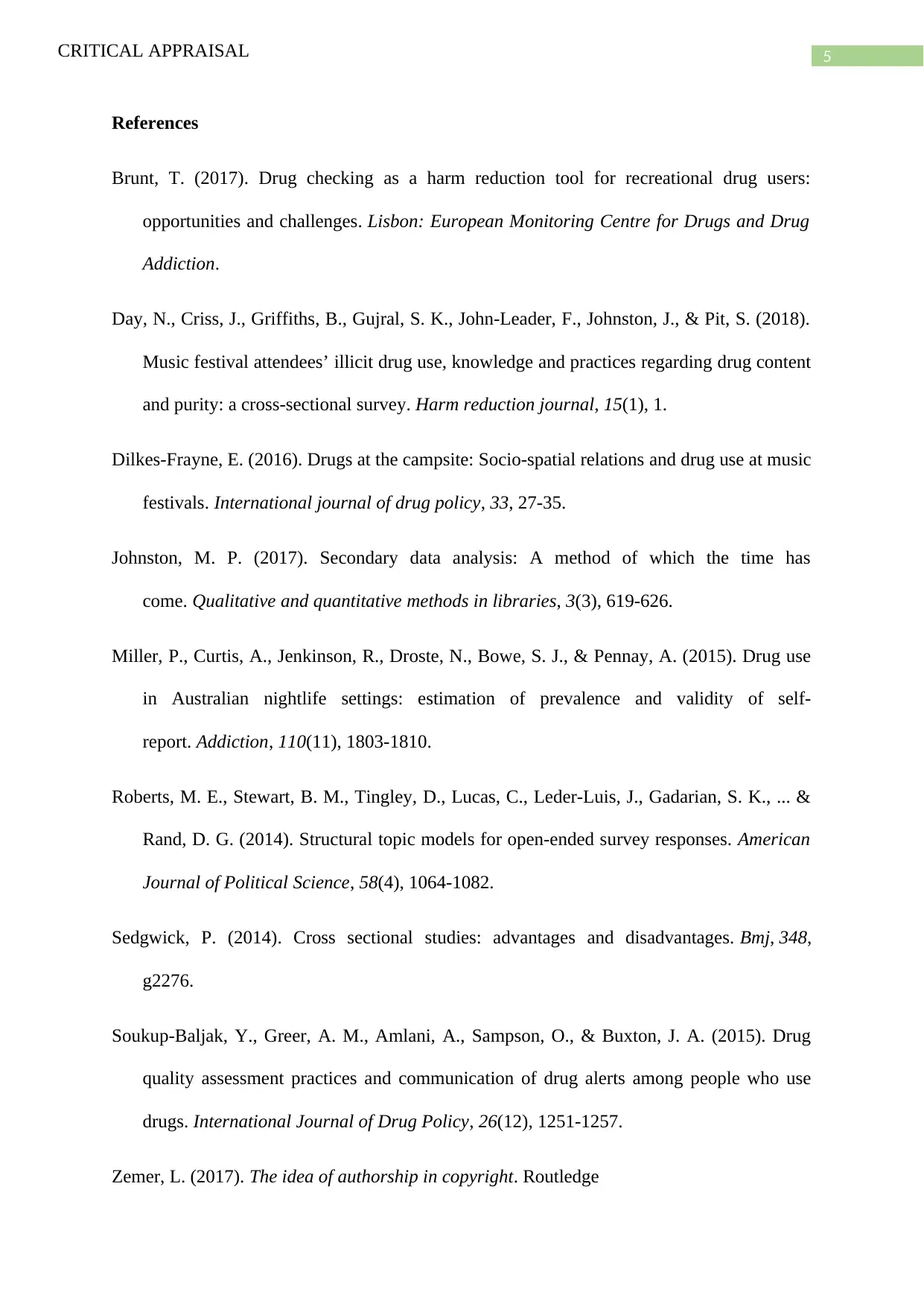
5CRITICAL APPRAISAL
References
Brunt, T. (2017). Drug checking as a harm reduction tool for recreational drug users:
opportunities and challenges. Lisbon: European Monitoring Centre for Drugs and Drug
Addiction.
Day, N., Criss, J., Griffiths, B., Gujral, S. K., John-Leader, F., Johnston, J., & Pit, S. (2018).
Music festival attendees’ illicit drug use, knowledge and practices regarding drug content
and purity: a cross-sectional survey. Harm reduction journal, 15(1), 1.
Dilkes-Frayne, E. (2016). Drugs at the campsite: Socio-spatial relations and drug use at music
festivals. International journal of drug policy, 33, 27-35.
Johnston, M. P. (2017). Secondary data analysis: A method of which the time has
come. Qualitative and quantitative methods in libraries, 3(3), 619-626.
Miller, P., Curtis, A., Jenkinson, R., Droste, N., Bowe, S. J., & Pennay, A. (2015). Drug use
in Australian nightlife settings: estimation of prevalence and validity of self‐
report. Addiction, 110(11), 1803-1810.
Roberts, M. E., Stewart, B. M., Tingley, D., Lucas, C., Leder‐Luis, J., Gadarian, S. K., ... &
Rand, D. G. (2014). Structural topic models for open‐ended survey responses. American
Journal of Political Science, 58(4), 1064-1082.
Sedgwick, P. (2014). Cross sectional studies: advantages and disadvantages. Bmj, 348,
g2276.
Soukup-Baljak, Y., Greer, A. M., Amlani, A., Sampson, O., & Buxton, J. A. (2015). Drug
quality assessment practices and communication of drug alerts among people who use
drugs. International Journal of Drug Policy, 26(12), 1251-1257.
Zemer, L. (2017). The idea of authorship in copyright. Routledge
References
Brunt, T. (2017). Drug checking as a harm reduction tool for recreational drug users:
opportunities and challenges. Lisbon: European Monitoring Centre for Drugs and Drug
Addiction.
Day, N., Criss, J., Griffiths, B., Gujral, S. K., John-Leader, F., Johnston, J., & Pit, S. (2018).
Music festival attendees’ illicit drug use, knowledge and practices regarding drug content
and purity: a cross-sectional survey. Harm reduction journal, 15(1), 1.
Dilkes-Frayne, E. (2016). Drugs at the campsite: Socio-spatial relations and drug use at music
festivals. International journal of drug policy, 33, 27-35.
Johnston, M. P. (2017). Secondary data analysis: A method of which the time has
come. Qualitative and quantitative methods in libraries, 3(3), 619-626.
Miller, P., Curtis, A., Jenkinson, R., Droste, N., Bowe, S. J., & Pennay, A. (2015). Drug use
in Australian nightlife settings: estimation of prevalence and validity of self‐
report. Addiction, 110(11), 1803-1810.
Roberts, M. E., Stewart, B. M., Tingley, D., Lucas, C., Leder‐Luis, J., Gadarian, S. K., ... &
Rand, D. G. (2014). Structural topic models for open‐ended survey responses. American
Journal of Political Science, 58(4), 1064-1082.
Sedgwick, P. (2014). Cross sectional studies: advantages and disadvantages. Bmj, 348,
g2276.
Soukup-Baljak, Y., Greer, A. M., Amlani, A., Sampson, O., & Buxton, J. A. (2015). Drug
quality assessment practices and communication of drug alerts among people who use
drugs. International Journal of Drug Policy, 26(12), 1251-1257.
Zemer, L. (2017). The idea of authorship in copyright. Routledge
⊘ This is a preview!⊘
Do you want full access?
Subscribe today to unlock all pages.

Trusted by 1+ million students worldwide

6CRITICAL APPRAISAL
1 out of 7
Related Documents
Your All-in-One AI-Powered Toolkit for Academic Success.
+13062052269
info@desklib.com
Available 24*7 on WhatsApp / Email
![[object Object]](/_next/static/media/star-bottom.7253800d.svg)
Unlock your academic potential
Copyright © 2020–2025 A2Z Services. All Rights Reserved. Developed and managed by ZUCOL.





